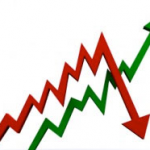 The major indices rose around 1% each on Thursday, bolstered by a lot of good news and an easing of worries over rising bond prices. Since every investor is exposed to macroeconomic trends–the systemic risk that is unavoidably part of every portfolio–it is important for even investors steeped in fundamental analysis to keep an eye on macro trends. And yesterday was a good day to cheer, as those indicators continue to indicate a slow but steady improvement in the American economy
The major indices rose around 1% each on Thursday, bolstered by a lot of good news and an easing of worries over rising bond prices. Since every investor is exposed to macroeconomic trends–the systemic risk that is unavoidably part of every portfolio–it is important for even investors steeped in fundamental analysis to keep an eye on macro trends. And yesterday was a good day to cheer, as those indicators continue to indicate a slow but steady improvement in the American economy
Slow and steady is good. It does not result in bubbles (or at least not as quickly), and it provides a steady environment that should make credit more available and encourage consumers to spend. Such trendlines would feed into each other and cause a growing economy, and should cause equities to rise steadily in the long term.
Let’s take a look at the headlines and see why they are boosting equities.
Banks Expect Housing Prices to Rise
This piece explains why, paradoxically, a jump in foreclosures could actually be a good thing. Banks seem to move forward with foreclosures more aggressively, as they see property as assets that will appreciate more than an albatross on their necks. The expectation of appreciating real estate shouldn’t surprise anyone; according to the S&P/Case-Shiller index, residential properties went up 11 percent in the year ending March.
Several private equity firms and hedge funds smell a quick buck, and have been entering the market in a series of high profile moves. It’s no surprise to see investment banks taking a similar tack.
Jobless Claims Unexpectedly Fell
The Labor Department reported that benefit claims fell by 12,000, above most analysts’ expectations, to a seasonally-adjusted 334,000 in May.
Less jobless does not necessarily mean more employed. People can (and, at a record rate since 2008, do) leave the workforce voluntarily, and are no longer counted in the unemployment rate. But less claims is less of a drain on government expenses and cannot be accounted for by people giving up on work. Separate news stories pointing to a rise in job openings and hiring activity suggest that the disastrous labor market is becoming a bit less terrible. Again, this points to a steady recovery.
Retail Sales are Up
Unexpectedly, retail sales jumped by 0.4% in May, far above analysts’ expectations. That growth was thanks mostly to auto sales, which many analysts have seen as a growth engine in a steadily recovering market.
The fact that consumers are more willing to spend money on big ticket items like a new car is significant. There are two types of growing retail spending trends. The first is on small ticket items–little treats that consumers tend to give themselves when they are exhausted with tough times. Then there is the big ticket item, which consumers tend to treat themselves with when they are feeling more confident with the economy.
Consumer confidence translates into consumer spending, which translates into revenue, and that translates into raised dividends and stock prices. So the retail numbers have helped the market broadly recover from a very bad Wednesday.
The Fed Reserve Risk
So we have a bunch of great news. That’s great, but we live in interesting times. While the good news is clearly good, it’s also bad in a sense, because enough good news could mean that the Federal Reserve will scale back stimulus, which would make leverage more expensive and cause credit to flow less easily. In theory, a strong economy would mean the credit would flow strong anyway, because business is booming and plenty of people will qualify for credit and get the income from economic activity to pay loans back. However, that is theory, and investors like certainty.
